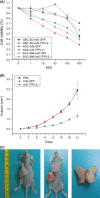Adenovirus-mediated gene transfer of tissue factor pathway inhibitor-2 inhibits gallbladder carcinoma growth in vitro and in vivo
- PMID: 22320835
- PMCID: PMC7659267
- DOI: 10.1111/j.1349-7006.2012.02218.x
Adenovirus-mediated gene transfer of tissue factor pathway inhibitor-2 inhibits gallbladder carcinoma growth in vitro and in vivo
Abstract
Tissue factor pathway inhibitor-2 (TFPI-2) has been identified as a tumor suppressor gene in several types of cancers, but its role in gallbladder carcinoma (GBC) is yet to be determined. In the present study, TFPI-2 expression in GBC tissues was examined, and its inhibitory activities against GBC growth were evaluated in vitro and in vivo after adenovirus-mediated gene transfer of TFPI-2 (Ad5-TFPI-2) was constructed to restore the expression of TFPI-2 in GBC cell lines (GBC-SD, SGC-996, NOZ) and xenograft tumors. Immunohistochemical staining showed that TFPI-2 was significantly downregulated in GBC tissue specimens. Ad5-TFPI-2 could significantly inhibit GBC growth both in vitro and in vivo. Apoptosis analysis and western blotting assay demonstrated that Ad5-TFPI-2 could induce the apoptosis of both GBC cell lines and tissues by promoting the activities of cytochrome c, Bax, caspase-3 and -9 and suppressing Bcl-2 activity. These data indicated that TFPI-2 acts as a tumor suppressor in GBC, and may have a potential role in gene therapy for GBC.
© 2012 Japanese Cancer Association.
Figures





Similar articles
-
[The role of tissue factor pathway inhibitor-2 gene in gallbladder cancer].Zhonghua Wai Ke Za Zhi. 2012 Dec;50(12):1099-103. Zhonghua Wai Ke Za Zhi. 2012. PMID: 23336488 Chinese.
-
mda-7/IL-24 induces apoptosis in human GBC-SD gallbladder carcinoma cells via mitochondrial apoptotic pathway.Oncol Rep. 2011 Jan;25(1):195-201. Oncol Rep. 2011. PMID: 21109977
-
Inhibitory effects of deleted in liver cancer 1 gene on gallbladder cancer growth through induction of cell cycle arrest and apoptosis.J Gastroenterol Hepatol. 2014 May;29(5):964-72. doi: 10.1111/jgh.12486. J Gastroenterol Hepatol. 2014. PMID: 24329682
-
Down-regulation of FoxM1 inhibits viability and invasion of gallbladder carcinoma cells, partially dependent on inducement of cellular senescence.World J Gastroenterol. 2014 Jul 28;20(28):9497-505. doi: 10.3748/wjg.v20.i28.9497. World J Gastroenterol. 2014. PMID: 25071344 Free PMC article.
-
Toward an understanding of tissue factor pathway inhibitor-2 as a novel serodiagnostic marker for clear cell carcinoma of the ovary.J Obstet Gynaecol Res. 2021 Sep;47(9):2978-2989. doi: 10.1111/jog.14916. Epub 2021 Jun 28. J Obstet Gynaecol Res. 2021. PMID: 34184357 Review.
Cited by
-
Decreased expression of TFPI-2 correlated with increased expression of CD133 in cholangiocarcinoma.Int J Clin Exp Pathol. 2015 Jan 1;8(1):328-36. eCollection 2015. Int J Clin Exp Pathol. 2015. PMID: 25755719 Free PMC article.
-
[Effects of decitabine on proliferation capacity and TFPI-2 expression in leukemia K562 cells].Zhonghua Xue Ye Xue Za Zhi. 2017 Apr 14;38(4):340-343. doi: 10.3760/cma.j.issn.0253-2727.2017.04.016. Zhonghua Xue Ye Xue Za Zhi. 2017. PMID: 28468099 Free PMC article. Chinese. No abstract available.
-
Tissue factor pathway inhibitor-2 (TFPI-2)-an underappreciated partaker in cancer and metastasis.Cancer Metastasis Rev. 2024 Dec;43(4):1185-1204. doi: 10.1007/s10555-024-10205-7. Epub 2024 Aug 17. Cancer Metastasis Rev. 2024. PMID: 39153052 Free PMC article. Review.
-
Beneficial role of overexpression of TFPI-2 on tumour progression in human small cell lung cancer.FEBS Open Bio. 2013 Jun 27;3:291-301. doi: 10.1016/j.fob.2013.06.004. Print 2013. FEBS Open Bio. 2013. PMID: 23905012 Free PMC article.
-
Promoter hypermethylation and silencing of tissue factor pathway inhibitor-2 in oral squamous cell carcinoma.J Transl Med. 2014 Sep 2;12:237. doi: 10.1186/s12967-014-0237-7. J Transl Med. 2014. PMID: 25179542 Free PMC article.
References
-
- Misra S, Chaturvedi A, Misra NC, Sharma ID. Carcinoma of the gallbladder. Lancet Oncol 2003; 4: 167–76. - PubMed
-
- Eslick GD. Epidemiology of gallbladder cancer. Gastroenterol Clin North Am 2010; 39: 307–30, ix. - PubMed
-
- de Aretxabala X, Roa I, Berrios M et al Chemoradiotherapy in gallbladder cancer. J Surg Oncol 2006; 93: 699–704. - PubMed
-
- Gourgiotis S, Kocher HM, Solaini L, Yarollahi A, Tsiambas E, Salemis NS. Gallbladder cancer. Am J Surg 2008; 196: 252–64. - PubMed
-
- Saetta A, Lazaris AC, Michalopoulos NV, Davaris PS. Genetic alterations involved in the development of gallbladder carcinomas from Greek patients. Hepatogastroenterology 2001; 48: 1284–8. - PubMed
Publication types
MeSH terms
Substances
LinkOut - more resources
Full Text Sources
Medical
Research Materials
Miscellaneous

